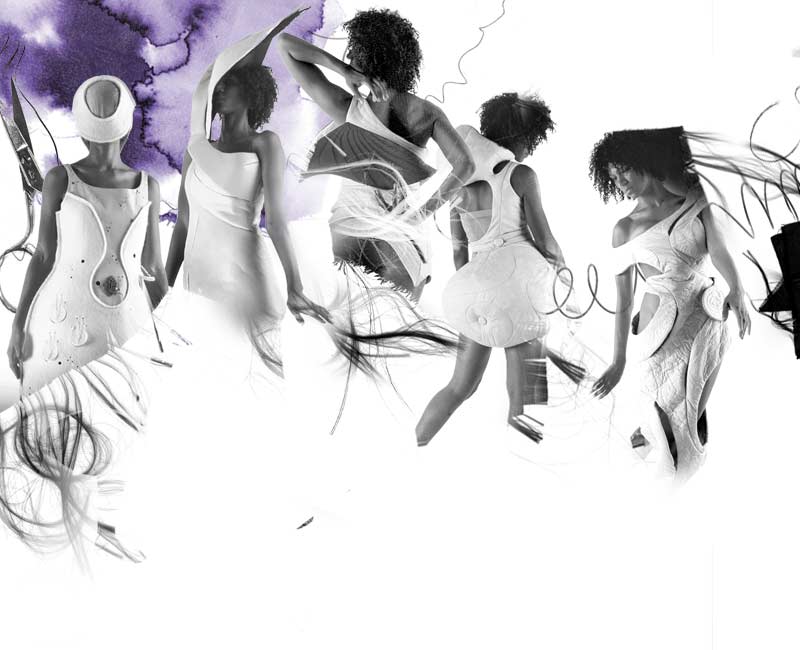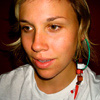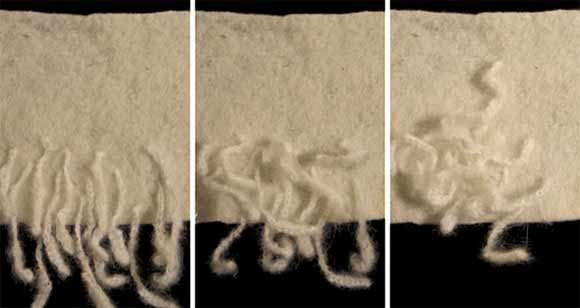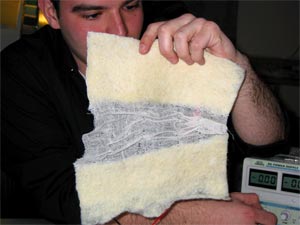SKORPIONS reference the history of garments as instruments of pain and desire. They hurt you and distort your body the same way as corsets and foot binding. They emphasize our lack of control over our garments and our digital technologies. Our clothes shift and change in ways that we do not anticipate. Our electronics malfunction and become obsolete.
SKORPIONS shift and modulate personal and social space by imposing physical constraints on the body. They alter behavior, by hiding or revealing hidden layers, inviting others inside the protective shells of fabric, by erecting breathable walls, or tearing themselves open to divulge hidden secrets.

SKORPIONS are a set of kinetic electronic garments that move and change on the body in slow, organic motions. They have anthropomorphic qualities and can be imagined as parasites that inhabit the skin of the host. They breathe and pulse, controlled by their own internal programming. They are not “interactive” artifacts insofar as their programming does not respond to simplistic sensor data. They have intentionality; they are programmed to live, to exist, to subsist. They are living behavioral kinetic sculptures that exploit characteristics such as control, anticipation, and unpredictability. They have their own personalities, their own fears and desires.
SKORPIONS integrate electronic fabrics, the shape-memory alloy Nitinol, mechanical actuators such as magnets, soft electronic circuits, and traditional textile construction techniques such as sculptural folds and drapes of fabric across the body. The cut of the pattern, the seams, and other construction details become an important component of engineering design.
SKORPIONS integrate electronic fabrics, the shape-memory alloy Nitinol, mechanical actuators such as magnets, soft electronic circuits, and traditional textile construction techniques such as sculptural folds and drapes of fabric across the body. The cut of the pattern, the seams, and other construction details become an important component of engineering design.


SLOFA is the bastard child of a snail and an elegant upholstered divan. It is sculpted out of heavy upholstery foam, covered with a rich ivory-colored brocade and lined internally with dusty purple silk. The contours of the pattern swirl around the shell to intersect its form. Its padded shoulder piece provides a resting place for a tired neck. It is a wearable piece of furniture that slows down the host and promotes laziness. SLOFA has a slithery internal petticoat and pearly dongles that move in and out of the shell. Shape memory alloy (SMA) coils allow the dongles to rise and fall, giving the appearance of jeweled tentacles that creep out to experience the world and retreat back when they’re satiated or afraid.
SLOFA is a parasitic growth whose bulbous form offers its host slovenly comfort. Its shapely bulk supports a weak spine and camouflages the love handles. Its deformed architectural structure grows around the host, restricting the body, accumulating deposits with time. The large protective shell roams the body like a rampant fungus, offering dank nooks in which to hide. One such nook releases slimy globules that leave the shell to graze the knees, smell the air, and dangle around until they have had enough and retreat back into their cushioned hiding place.

 |
 |
 |
 |
 |
 |








ENELEON is constructed out of heavy hand-made felt, creamy leather, and reflective lamÈ lining. It is shaped like a large bilateral symmetric pod that encloses the body from front and back. The materials are perforated with small decorative holes that allow some airflow around the body. Each side features six scattered scales that rise and lower in order to reveal a mirrored lining. The movement is activated by beaded shape memory alloy (SMA) coils, controlled through custom electronics. A sculpted felt mask obscures the face with reflective chain mail, further erasing the hostís identity. The front and the back are identical, so the host assumes an element of radial as well as bilateral symmetry.
ENELEON mirrors your every fear and desire. Its soft pod shell encases the host like a clam. Its seductive flaps move up and down to reveal reflective scales that mirror your own insecurities. ENELEON is everything to everyone, but its multifaceted personality also makes it inscrutable and enigmatic. Some say that its reflective exterior disguises a malignant envy, rotting inside.

 |
 |
 |
 |
 |
 |





 |
||
 |
||
 |
 |
|

LUTTERGILL is built out of soft quilted cotton with an elegant, cocoon-like silhouette, stitched to mirror the contours of the female form. Several seams slowly roll open and peel apart to reveal and release slices of iridescent color. The movement of these gill-like details is enabled by filaments of shape memory alloy (SMA) stitched into the inside of the fissures. The SMA is controlled through our custom electronics board. LUTTERGILL twists and narrows around the waist, morphing into a belt that encircles the body and is fastened in the front with a bespoke leather clasp. LUTTERGILL is accessorized with a beautiful asymmetric skullcap that shields half of the face and curls around to accentuate the exposed eye.
LUTTERGILL is a cocoon about to burst open as the host, who pupates inside its elegant folds, strives to escape. The quilted shell is constructed with built-in lines of weakness along which the host can tear easily from inside and create exit holes that only allow a one-way passage out. In so doing, the soft shell is slowly coming apart at the seams, breathing, opening, threatening to liberate the beautiful blue silk hidden inside.

 |
 |
 |
 |
 |
 |









SKWRATH is a quilted leather bodice, constructed out of stony leather lined with blood red silk. It integrates a sculptural wing-like collar around the head that can be used to conceal the face of the host and can be torn open to reveal the scarlet lining. The abdomen is made up of three interlocking leather segments or plates, embroidered with threads of shape memory alloy (SMA), which are activated through a custom electronic board to contract and curl back to reveal deep slashes of red silk.
SKWRATH is a loner warrior that acts on instinct. Its leather carapace snarls and retreats over its bloody red interior. Its face shield hides and disguises the hostís intentions and emotions. Only one eye is revealed. Its skirt contracts to warn people to keep their distance, to stand back. When they get too close, its plates crawl back and retract. Blood gushes forth. The interlocking plates of the SKWRATH armor twist around the body like a spiraling abdomen.

 |
 |
 |
 |
 |
 |










GLUTUS is an elegant off-the-shoulder dress that uses a combination of silk, leather, and felt to outline a streamlined, organic silhouette. A sculptural panel of leather attaches to the left breast and swoops around the right shoulder and the face to become a large leaf-shaped hat. The hat is embroidered with filaments of the shape memory alloy Nitinol on the top and the underside, so that the leaf can curl up and down around the head, as if trying to envelop and consume the face of the host. The cannibalistic implications of this movement reference the sadistic aspects of the fashion industry, where womenís (and menís) bodies have been distorted and abused for the sake of style. There is also a suggestion of the modelís body becoming emaciated and the identity of the model being erased. Although the headpiece appears to grow out of the body of the dress, seamlessly integrated into the silhouette, it is in fact a distinct element that can be removed and is secured in place with a series of magnets. Its structure encloses all the electronic components as well as the power source, addressing safety and access concerns.
GLUTUS is the most seductive of all the garments. Her inverted tulip skirt is very playful, but the leaf-shaped hat could not be more menacing. She is enchanting, with curves in all the right places, but stories of this man-eating fiend have been whispered across generations. She has the kind of molten sex appeal that successfully camouflages her voracious appetite. Her insatiable cannibalism is, however, a touch bourgeois.

 |
 |
 |
 |
 |
 |









photographs click for hi-res image
Photos © XS Labs 2007
taken by Nico Stinghe,
Karen Zalamea and Michael Love
models Myriam Magassouba,
Meghan Maike
Photos © XS Labs 2007
taken by Nico Stinghe,
Karen Zalamea and Michael Love
models Myriam Magassouba,
Meghan Maike
SKWRATH
ENLEON
SLOFA
LUTTERGILL
GLUTUS
 |  |
 |
 |
 |
 |
 |  |
 |
 |
 |
 |
 |  |
 |
 |
 |
 |
 |  |
 |
 |
 |
 |
 |  |
 |
 |
 |
 |


video
enleon |
enleon |
enleon |
skwrath |
skwrath |
slofa |
luttergill |
luttergill |
glutus |
glutus |
-- |
-- |
di beading |
nitinol |
di ironing |
david programming |
marguerite |
-- |

team
Joanna Berzowska



Joanna Berzowska is Associate Professor of Design and Computation Arts at Concordia University and a member of the Hexagram Research Institute in Montreal. She is the founder and research director of XS Labs, where her team develops innovative methods and applications in electronic textiles and responsive garments.
Her art and design work has been shown in the Cooper-Hewitt Design Museum in NYC, the V&A in London, the Millenium Museum in Beijing, SIGGRAPH Art Galleries, ISEA, the Art Directors Club in NYC, the Australian Museum in Sydney, NTT ICC in Tokyo, and Ars Electronica Center in Linz among others.
She lectures internationally about the field of electronic textiles and related social, cultural, aesthetic, and political issues. She was recently selected for the Maclean's 2006 Honour Roll as one of "thirty nine Canadians who make the world a better place to live".
She received her Masters of Science from MIT for her work titled Computational Expressionism and subsequently worked with the Tangible Media Group of the MIT Media Lab and cofounded International Fashion Machines in Boston. She holds a BA in Pure Math and a BFA in Design Arts.
Di
Mainstone

Mainstone


Trained in fashion design at Central Saint Martins College of Art, London, Di Mainstone's eccentric style caught the attention of press during a design partnership with cult UK labels Soochi and Choosi. Her fashion soon became a favourite of celebrities, selling internationally at boutiques such as Harvey Nichols, Selfridges and Urbanoutfitters. Further design collaborations included illustrations at Jimmy Choo, accessories and homewares at UrbanOutfitters and prints at Topshop.
Following a series of experimental fashion collaborations with engineers, dancers and architects, Di joined Sara Diamond at the Banff New Media Institute to create a series of electronic fashion garments, Company Keeper and Emotional Ties. Shortly afterwards Di joined forces with Joey Berzowska, founder of XS Labs, Montreal. Together they produced Skorpions.
Di MainstoneÌs interactive couture has been exhibited widely: Los Angeles, Pisa, Montreal, Toronto, Banff and Cardiff. Her portfolio has also led to workshops and lecturing with textile futures students at Central Saint Martins, College of Art, London and design students at Concordia University, Montreal.
www.dimainstone.com
www.dimainstone.com


Marguerite Bromley
Marguerite Bromley is a textile artist based in Montreal, working on large scale sculptural fibre art often with a hint of interactive electronics. She is researcher and creator at XS Labs as well as an art educator. Marguerite holds a BFA in Art Education from Concordia University and has taught workshop in Montreal, SIGGRAPH in Boston and the National Institute of Design in Ahmedabad, India. She has exhibited throughout Canada and the US and cast a bit of textiles art into everyday life.


Marcelo
Coelho
Coelho
Marcelo Coelho is a Graduate Student at the Ambient Intelligence Group at the MIT Media Lab, in Cambridge, USA. His work explores how technology can refashion communication by incorporating computation into common substrates, materials and structures. Some of his projects include experimental websites, reactive garments, flying robots and edible circuits.
Marcelo holds a BFA in Computation Arts, with highest honors, from Concordia University in Montreal, Canada. Before joining the MIT Media Lab, Marcelo worked as a researcher at XS Labs developing wearable technology and interactive textiles.
His art and computational explorations have been published and showed at the Societe des arts technologiques (2003), VAV Gallery (2004), Digifest (2004), Collision Collective (2007), SIGGRAPH (2003, 2005, 2006, 2007), ISWC (2005), Ubicomp (2007) and CHI (2006), among others.
homepage
Marcelo holds a BFA in Computation Arts, with highest honors, from Concordia University in Montreal, Canada. Before joining the MIT Media Lab, Marcelo worked as a researcher at XS Labs developing wearable technology and interactive textiles.
His art and computational explorations have been published and showed at the Societe des arts technologiques (2003), VAV Gallery (2004), Digifest (2004), Collision Collective (2007), SIGGRAPH (2003, 2005, 2006, 2007), ISWC (2005), Ubicomp (2007) and CHI (2006), among others.
homepage


David
Gauthier
Gauthier
David Gauthier navigates the subtle channel between Arts and Sciences. With a BA in Mathematics in his suitcase, Gauthier set off for the Banff New Media Institute in 2004, where he created innovative technologies in the field of wearable and nomad computing. He continued his quest at the Hexagram Institute where he collaborated with diverse research groups such as MDCN, XSLabs, Topological Media Lab, IDMIL McGill, Interstices and BASH. Now based in Cambridge, Massachusetts, Gauthier is pursuing a Master of Science degree at the MIT Media Lab within the Viral Communication Group. His scientific research and artistic experiments have been published and exhibited at venues such as Siggraph, ACE, CHI, ICMC and DiGRA. Fascinated by mixing pattern cutting technics with Kalman filters, Gauthier aims to one day create an intelligent tuxedo.


Francis
Raymond
Raymond
Francis Raymond is a multidisciplinary artist working mainly with electronics, video and sound elements. He is completing his B.F.A. at Concordia University, majoring in IMCA with a minor in Computation Arts. Being a researcher at XS Labs gave him the opportunity to open up to the world of textiles, and he will pursue some work in that direction in the future.


Valerie
Boxer
Boxer
ValÈrie Boxer is a multidisciplinary artist currently finishing her
BFA in Intermedia and Cyber Arts at Concordia University in Montreal.
With a background involving fibers, performance art, video and
interactive medias, she strives to translate the uncanniness of daily
routines through her art. During the past years ValÈrie has worked in
the field of art education as a gallery guide and has touched upon the
world of wearable technology as a research assistant at XS Labs. She
hopes to continue investigating the possibilities of cross
pollination between art and other disciplines and to disseminate
hybrid propositions for living through her creations.

technology
page for print
SKORPIONS: behind the scenes
Joanna Berzowska & Marcelo Coelho
SKORPIONS are 5 kinetic electronic garments that use the shape-memory alloy (SMA) Nitinol to move and change on the body in slow, organic motions. The idea of integrating Nitinol into textiles is an obvious way of achieving shape changing, responsive fabrics. However, even though it sounds simple, the process is quite complicated and expensive, as can be seen by the lack of Nitinol-based shape changing garments on the market today.
SKORPIONS integrate electronic fabrics, soft electronic circuits, specially designed circuit boards, Nitinol, mechanical actuators such as magnets, and traditional textile construction techniques such as sculptural folds and drapes of fabric across the body. The cut of the pattern, the seams, and other construction details become an important component of engineering design.
SKORPIONS are not interactive: their programming does not respond to sensor data. They are more like living organisms or moving sculptures that display characteristics such as control, anticipation, and unpredictability.
NITINOL
Nitinol, also known as muscle wire, is a shape memory alloy (SMA) of nickel and titanium that has the ability to indefinitely remember its geometry. The range of applications has been increasing in recent years, especially in medicine, with the development of dental braces that exert a constant pressure on the teeth or stents used to keep arteries open. Due to energy inefficiency, slow response times, and large hysteresis, these materials are not currently appropriate for applications such as robotics or artificial muscles.
During its relaxed (or martensite) state, Nitinol is extremely malleable and resistant; it can be integrated into a soft fabric substrate without causing any disruption in its natural movement and flexibility. On the other hand, once heated to its shape memory (or austenite) state, a Nitinol wire becomes stiff and returns to its original shape with enough force to lift its own weight several times. The shape setting process for the wire happens around 500† C, so it is impossible to shape the Nitinol after integration into the fabric (unless we use materials like Kevlar). This limits design and fabrication possibilities.
To develop the kinetic mechanisms utilized in the Skorpions, it was necessary to explore several custom shaped Nitinol wires and their integration with textile techniques like knitting, sewing, and hand stitching. We did not try the Nitinol in the sewing machine, because it is thicker and more rigid than standard sewing thread.
Nitinol wire that has been previous shape-set can be knit into a wool yarn or stitched onto a surface. The first set of photos show a prototype of knitting Nitinol coils directly into a yarn and the resulting kinetic worms. The second photo shows a prototype of two-colored felt scales that bend to reveal a different color.
Photos by Shermine Sawalha.


 Nitinol wire that has been previous shape-set can be woven into a textile in its martensite state. In the photo, Marcelo connects power to the sample to make it shrink. Photo by Tracey Doyle.
Nitinol wire that has been previous shape-set can be woven into a textile in its martensite state. In the photo, Marcelo connects power to the sample to make it shrink. Photo by Tracey Doyle.
NITINOL FABRICATION
We can control the specific shape-change and the specific temperature at which the change occurs. The material needs to be constrained in the desired shape, heated to 500ƒC, and then quenched in water at room temperature. The following photos by Jacques Teisen show the process of shaping the Nitinol wire on a long screw, the furnace where the material is inserted for ìprogrammingî the shape, and the final shape memory (or austenite) state.

ELECTRONICS Textiles are traditionally flexible surfaces that can softly envelop the human body. To successfully merge textiles with electronics (which are traditionally hard), we need to develop new methods for making circuits. Our approach at XS Labs involves the use of conductive yarns, inks, and fabrics to allow the construction of soft electronic circuits. The traditional textile materials and construction methods such as sewing, weaving, embroidery, and knitting allow us to merge functionality and aesthetics in our design process. For instance, we connect our custom control electronics to the Nitinol coils with decorative stitching made with conductive thread.
 The use of snaps is another technique that allows a durable and seamless connection between the flexible threads and the rigid PCB (printed circuit board). The male snaps are soldered to the PCB, while the female are sewn into the dress and connected to the conductive thread with conductive epoxy. A small inside pocket holds the electronics and insulates them from skin and moisture. This modular assembly allows for the board to be completely removed when necessary, separating soft from hard electronics. photo by Damir Cheremisov
The use of snaps is another technique that allows a durable and seamless connection between the flexible threads and the rigid PCB (printed circuit board). The male snaps are soldered to the PCB, while the female are sewn into the dress and connected to the conductive thread with conductive epoxy. A small inside pocket holds the electronics and insulates them from skin and moisture. This modular assembly allows for the board to be completely removed when necessary, separating soft from hard electronics. photo by Damir Cheremisov
Nitinol is not only used as the scaffold for the desired shape change, but it can also, through resistive heating, produce the heat necessary for actuation. Since the Nitinol wire needs to undergo a temperature change of approximately 40 †C to be activated, it requires a considerable amount of power. These requirements are met by two small rechargeable lithium polymer cells that can power the dresses for a couple of hours, depending on the timing and frequency of activation.
Joanna Berzowska & Marcelo Coelho
SKORPIONS are 5 kinetic electronic garments that use the shape-memory alloy (SMA) Nitinol to move and change on the body in slow, organic motions. The idea of integrating Nitinol into textiles is an obvious way of achieving shape changing, responsive fabrics. However, even though it sounds simple, the process is quite complicated and expensive, as can be seen by the lack of Nitinol-based shape changing garments on the market today.
SKORPIONS integrate electronic fabrics, soft electronic circuits, specially designed circuit boards, Nitinol, mechanical actuators such as magnets, and traditional textile construction techniques such as sculptural folds and drapes of fabric across the body. The cut of the pattern, the seams, and other construction details become an important component of engineering design.
SKORPIONS are not interactive: their programming does not respond to sensor data. They are more like living organisms or moving sculptures that display characteristics such as control, anticipation, and unpredictability.
NITINOL
Nitinol, also known as muscle wire, is a shape memory alloy (SMA) of nickel and titanium that has the ability to indefinitely remember its geometry. The range of applications has been increasing in recent years, especially in medicine, with the development of dental braces that exert a constant pressure on the teeth or stents used to keep arteries open. Due to energy inefficiency, slow response times, and large hysteresis, these materials are not currently appropriate for applications such as robotics or artificial muscles.
During its relaxed (or martensite) state, Nitinol is extremely malleable and resistant; it can be integrated into a soft fabric substrate without causing any disruption in its natural movement and flexibility. On the other hand, once heated to its shape memory (or austenite) state, a Nitinol wire becomes stiff and returns to its original shape with enough force to lift its own weight several times. The shape setting process for the wire happens around 500† C, so it is impossible to shape the Nitinol after integration into the fabric (unless we use materials like Kevlar). This limits design and fabrication possibilities.
To develop the kinetic mechanisms utilized in the Skorpions, it was necessary to explore several custom shaped Nitinol wires and their integration with textile techniques like knitting, sewing, and hand stitching. We did not try the Nitinol in the sewing machine, because it is thicker and more rigid than standard sewing thread.
Nitinol wire that has been previous shape-set can be knit into a wool yarn or stitched onto a surface. The first set of photos show a prototype of knitting Nitinol coils directly into a yarn and the resulting kinetic worms. The second photo shows a prototype of two-colored felt scales that bend to reveal a different color.
Photos by Shermine Sawalha.


 Nitinol wire that has been previous shape-set can be woven into a textile in its martensite state. In the photo, Marcelo connects power to the sample to make it shrink. Photo by Tracey Doyle.
Nitinol wire that has been previous shape-set can be woven into a textile in its martensite state. In the photo, Marcelo connects power to the sample to make it shrink. Photo by Tracey Doyle.NITINOL FABRICATION
We can control the specific shape-change and the specific temperature at which the change occurs. The material needs to be constrained in the desired shape, heated to 500ƒC, and then quenched in water at room temperature. The following photos by Jacques Teisen show the process of shaping the Nitinol wire on a long screw, the furnace where the material is inserted for ìprogrammingî the shape, and the final shape memory (or austenite) state.

ELECTRONICS Textiles are traditionally flexible surfaces that can softly envelop the human body. To successfully merge textiles with electronics (which are traditionally hard), we need to develop new methods for making circuits. Our approach at XS Labs involves the use of conductive yarns, inks, and fabrics to allow the construction of soft electronic circuits. The traditional textile materials and construction methods such as sewing, weaving, embroidery, and knitting allow us to merge functionality and aesthetics in our design process. For instance, we connect our custom control electronics to the Nitinol coils with decorative stitching made with conductive thread.
 The use of snaps is another technique that allows a durable and seamless connection between the flexible threads and the rigid PCB (printed circuit board). The male snaps are soldered to the PCB, while the female are sewn into the dress and connected to the conductive thread with conductive epoxy. A small inside pocket holds the electronics and insulates them from skin and moisture. This modular assembly allows for the board to be completely removed when necessary, separating soft from hard electronics. photo by Damir Cheremisov
The use of snaps is another technique that allows a durable and seamless connection between the flexible threads and the rigid PCB (printed circuit board). The male snaps are soldered to the PCB, while the female are sewn into the dress and connected to the conductive thread with conductive epoxy. A small inside pocket holds the electronics and insulates them from skin and moisture. This modular assembly allows for the board to be completely removed when necessary, separating soft from hard electronics. photo by Damir Cheremisov
Nitinol is not only used as the scaffold for the desired shape change, but it can also, through resistive heating, produce the heat necessary for actuation. Since the Nitinol wire needs to undergo a temperature change of approximately 40 †C to be activated, it requires a considerable amount of power. These requirements are met by two small rechargeable lithium polymer cells that can power the dresses for a couple of hours, depending on the timing and frequency of activation.

texts
 |
Press Release ///////////// ///////////// ///////////// ///////////// ///////////// |
 |
||
 |
Berzowska, J., Mainstone, D., Bromley, M., Coelho, M., Gauthier, D.,
Raymond, F., Boxer, V. Skorpions: Kinetic Electronic Garments, in the 9th International Conference on Ubiquitous Computing (Ubicomp '07). (Innsbruck, Austria, 2007) |
 |
||
 |
Berzowska, J. and Coelho, M. Kukkia and Vilkas: Kinetic Electronic Garments, in the 9th IEEE International Symposium on Wearable Computers (ISWC '05). (Osaka, Japan, 2005) |
 |
||
 |
 |
|||







